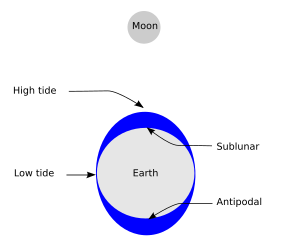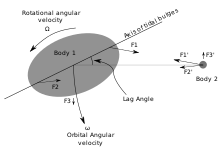
Back Gety Afrikaans Marea AN مد وجزر Arabic ܡܠܐܐ ܘܬܘܒܐ ARC مارية ARY Marea AST Qabarma və çəkilmə Azerbaijani Hukol BCL Gaba BDR Прылівы і адлівы Byelorussian



Tides are the rise and fall of sea levels caused by the combined effects of the gravitational forces exerted by the Moon (and to a much lesser extent, the Sun) and are also caused by the Earth and Moon orbiting one another.
Tide tables can be used for any given locale to find the predicted times and amplitude (or "tidal range"). The predictions are influenced by many factors including the alignment of the Sun and Moon, the phase and amplitude of the tide (pattern of tides in the deep ocean), the amphidromic systems of the oceans, and the shape of the coastline and near-shore bathymetry (see Timing). They are however only predictions, the actual time and height of the tide is affected by wind and atmospheric pressure. Many shorelines experience semi-diurnal tides—two nearly equal high and low tides each day. Other locations have a diurnal tide—one high and low tide each day. A "mixed tide"—two uneven magnitude tides a day—is a third regular category.[1][2][a]
Tides vary on timescales ranging from hours to years due to a number of factors, which determine the lunitidal interval. To make accurate records, tide gauges at fixed stations measure water level over time. Gauges ignore variations caused by waves with periods shorter than minutes. These data are compared to the reference (or datum) level usually called mean sea level.[3]
While tides are usually the largest source of short-term sea-level fluctuations, sea levels are also subject to change from thermal expansion, wind, and barometric pressure changes, resulting in storm surges, especially in shallow seas and near coasts.
Tidal phenomena are not limited to the oceans, but can occur in other systems whenever a gravitational field that varies in time and space is present. For example, the shape of the solid part of the Earth is affected slightly by Earth tide, though this is not as easily seen as the water tidal movements.
- ^ Reddy, M.P.M. & Affholder, M. (2002). Descriptive physical oceanography: State of the Art. Taylor & Francis. p. 249. ISBN 90-5410-706-5. OCLC 223133263. Archived from the original on 2023-09-16. Retrieved 2022-01-05 – via Google Books.
- ^ Hubbard, Richard (1893). Boater's Bowditch: The Small Craft American Practical Navigator. McGraw-Hill Professional. p. 54. ISBN 0-07-136136-7. OCLC 44059064. Archived from the original on 2023-09-16. Retrieved 2022-01-05 – via Google Books.
- ^ "Tidal lunar day". NOAA. Archived from the original on 2018-08-17. Retrieved 2007-04-07. Do not confuse with the astronomical lunar day on the Moon. A lunar zenith is the Moon's highest point in the sky.
Cite error: There are <ref group=lower-alpha> tags or {{efn}} templates on this page, but the references will not show without a {{reflist|group=lower-alpha}} template or {{notelist}} template (see the help page).